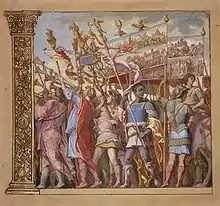
Andrea Andreani (1540–1623) was an Italian engraver on wood, who was among the first printmakers in Italy to use chiaroscuro, which required multiple colours.
Andreani was born and generally active in Mantua about 1540 (Brulliot says 1560) and died at Rome in 1623. His engravings are scarce and valuable, and are chiefly copies of Mantegna, Albrecht Dürer, Parmigianino and Titian. The most remarkable of his works are Mercury and Ignorance, the Deluge, Pharaoh's Host Drowned in the Red Sea (after Titian), the Triumph of Caesar (after Mantegna), and Christ retiring from the judgment-seat of Pilate after a relief by Giambologna.[1] He was active 1584–1610 in Florence.[2]
Andreani's work is held in several museums worldwide, including the Metropolitan Museum of Art,[3] the Museum of Fine Arts, Boston,[4] the Cleveland Museum of Art,[5] the Fine Arts Museums of San Francisco,[6] the Ackland Art Museum,[7] the Clark Art Institute,[8] the Harvard Art Museums,[9] the Victoria and Albert Museum,[10] the Albright–Knox Art Gallery,[11] the National Gallery of Canada,[12] the Davis Museum at Wellesley College,[13] the Cooper Hewitt,[14] the University of Michigan Museum of Art,[15] the Bowdoin College Museum of Art,[16] the Los Angeles County Museum of Art,[17] the Philadelphia Museum of Art,[18] the Princeton University Art Museum,[19] and the British Museum.[20]
References
- ↑ One or more of the preceding sentences incorporates text from a publication now in the public domain: Chisholm, Hugh, ed. (1911). "Andreani, Andrea". Encyclopædia Britannica. Vol. 1 (11th ed.). Cambridge University Press. p. 971.
- ↑ ULAN
- ↑ "Rape of a Sabine Woman – 1584 – Andrea Andreani Italian". www.metmuseum.org. Metropolitan Museum of Art. Retrieved 2021-01-11.
- ↑ "Woman Contemplating a Skull". collections.mfa.org. Museum of Fine Arts, Boston. Retrieved 2021-01-11.
- ↑ "Virgin and Child with St. John, St. Catherine of Siena and St. Francis". www.clevelandart.org. Cleveland Museum of Art. Archived from the original on 2019-04-11.
- ↑ "Andrea Andreani". art.famsf.org. Fine Arts Museums of San Francisco. 2018-09-21. Retrieved 2021-01-11.
- ↑ "The Triumph of Julius Caesar: The Musicians (no. 8), after Andrea Mantegna – Works – eMuseum". ackland.emuseum.com. Ackland Art Museum. Retrieved 2021-01-11.
- ↑ "The Surprised Man". www.clarkart.edu. Clark Art Institute. Retrieved 2021-01-11.
- ↑ Harvard. "From the Harvard Art Museums' collections Triumph of Julius Caesar". harvardartmuseums.org. Retrieved 2021-01-11.
- ↑ "Hercules Strangling the Nemean Lion | Andreani, Andrea | V&A Search the Collections". collections.vam.ac.uk. Victoria and Albert Museum. 2021-01-11. Retrieved 2021-01-11.
- ↑ "The Triumphs of Julius Caesar | Albright-Knox". www.albrightknox.org. Albright–Knox Art Gallery. Retrieved 2021-01-11.
- ↑ "An Allegory of Death". www.gallery.ca. National Gallery of Canada. Retrieved 2021-01-11.
- ↑ "Davis Museum at Wellesley College". dms.wellesley.edu. Davis Museum at Wellesley College. Retrieved 2021-01-11.
- ↑ "Print, Virgin and Child and St. John". collection.cooperhewitt.org. Cooper Hewitt, Smithsonian Design Museum. Retrieved 2021-01-11.
- ↑ "Exchange: Madonna and Child with a Bishop". exchange.umma.umich.edu. University of Michigan Museum of Art. Retrieved 2021-01-11.
- ↑ "EmbARK Web Kiosk - Christ Bearing the Cross, after Alessandro Casolani". artmuseum.bowdoin.edu. Bowdoin College Museum of Art. Retrieved 2021-01-11.
- ↑ "The Presentation in the Temple | LACMA Collections". collections.lacma.org. Los Angeles County Museum of Art. Retrieved 2021-01-11.
- ↑ "Collections Object: Frontispiece with Bust". www.philamuseum.org. Philadelphia Museum of Art. Retrieved 2021-01-11.
- ↑ "Presentation in the Temple (x1946-72)". artmuseum.princeton.edu. Princeton University Art Museum. Retrieved 2021-01-11.
- ↑ "print | British Museum". www.britishmuseum.org. British Museum. Retrieved 2021-01-11.
Sources
- "Andrea Andreani" in the Encyclopædia Britannica, 9th Edition, Vol. II, p. 20.
- Getty ULAN entry.
Further reading
- Ticozzi, Stefano (1830). Dizionario degli architetti, scultori, pittori, intagliatori in rame ed in pietra, coniatori di medaglie, musaicisti, niellatori, intarsiatori d'ogni etá e d'ogni nazione' (Volume 1). Milan: Gaetano Schiepatti. p. 53.
- artnet